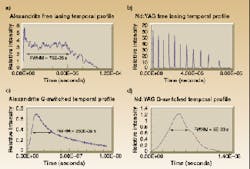SOLID-STATE LASERS: Alexandrite lasers make their mark in industrial applications
ROBERT BATTIS, JERRY KUPER, CATHERINE ANDERSON, and ALEX BEGER
Alexandrite laser-based marking and materials processing applications are emerging in the fields of telecommunications, microelectronics, and biomedical technology. Applications in these industries have until now been dominated by excimer, CO2, and Nd:YAG lasers. In the future, laser technology solutions will broaden as the unique advantages exhibited by alexandrite lasers become better known.
These lasers were initially researched and developed by AlliedSignal Corp. (now Honeywell; Morristown, NJ). The company invested more than $100 million in the development of alexandrite laser systems and the growth of high-quality laser material. It developed these lasers for military and government applications, such as laser isotope separation, man-portable laser countermeasures (weighing less than 45 lb), laser lidar applications, and low-light-level long-range (5 miles) illumination systems.
Medical applications such as laser lithotripsy were investigated but not commercially exploited. More recently, several companies have developed commercial alexandrite laser systems for tattoo and hair removal. Alexandrite lasers are now being introduced into scientific, medical, and industrial applications where the unique characteristics of these lasers provide a clear process and process integration advantage to its customers.
Emerging applications
Named for Russian Czar Alexander II, alexandrite was discovered in the Ural Mountains in the 1830s. This rare, naturally occurring material was first synthesized by the Czochralski method in the early 1970s. Chromium-doped chrysoberyl (Cr3+:BeAl2O4) material has excellent thermal mechanical properties that produce a robust solid-state laser material.
The natural birefringence and lack of thermally induced depolarization produces a simpler resonator design in lasers based on alexandrite. The fluorescent lifetime of 260 µs at room temperature and the broad spectral absorptions allow for efficient flashlamp excitation. The stimulated emission cross section of alexandrite increases with temperature, which allows for more-efficient extraction of the stored energy.
At Laser Energetics our conductively air-cooled, flashlamp-pumped alexandrite laser takes advantage of this property to provide greater than 3% optical efficiency in the free-lasing mode and greater than 1% in the Q-switched mode of operation. Additionally, the fundamental tuning envelope is extended to 860 nm using the air-cooling design.
In marking and materials-processing applications this spectral coverage provides distinct advantages when compared to the ranges of excimer, CO2, and Nd:YAG lasers. The alexandrite laser can tune from 720 to 860 nm at its fundamental wavelength, from 360 to 430 nm at the second harmonic, 240 to 280 nm at the third harmonic, and 190 to 215 nm at the fourth. These ranges add up to 275 nm of tunability: 140 nm in the fundamental visible/IR region and 135 nm in the UV harmonically converted regions.
In contrast, a non-OPO Nd:YAG laser can be tuned to 1064, 532, 355, 266, and 212 nm. An excimer also has five ranges: 157, 193, 248, 308, and 351 nm. The CO2 laser can emit at 10.6 or 9.6 µm.
Thus, more-efficient material interactions are possible with the alexandrite laser by tuning the wavelength to better match the absorption spectrum of the targeted materials. The emergence of alexandrite lasers into contract manufacturing and process-development services is being driven by the relative strengths of alexandrite (compared to the other lasers) for particular material-interaction applications.
Commercial impetus
Advances in alexandrite laser technology have provided the opportunity to use it effectively in commercial applications and, in many cases, provide performance superior to excimer, CO2, and Nd:YAG lasers. Two key features of the alexandrite laser are its ability to be air-cooled and the convenience of coupling the laser output into standard fused-silica fiberoptic cable for beam delivery. The conductive air-cooling provides a more efficient and, therefore, more compact laser system. Fiber coupling allows the laser and power supply to be removed from the process area (see Fig. 1).
In experiments comparing the material-removing capabilities of alexandrite, excimer, and Nd:YAG lasers using thin sheets of aluminum, copper, silver, stainless steel, titanium, and some other materials, the long-pulse TEM00 output of the alexandrite laser compared favorably with the others. All lasers used the same 40-mm-focal-length f/4 focusing lens.The long-pulse output of Nd:YAG (at 1064 nm) took multiple (up to 20) pulses to do the equivalent work of the alexandrite laser using one to three pulses, even though the 200-mJ pulse energy of the Nd:YAG was seven times greater than that of the alexandrite. The Q-switched Nd:YAG laser operating at 355 nm and 100 mJ/pulse needed 40-100 pulses to do the same work as one to three pulses of alexandrite at 760 nm with 1/3 the pulse energy (see Fig. 2). The excimer laser took 20-70 pulses, leaving a lot of flash with a large heat-affected zone.The focused fluences at the various wavelengths were excimer, 8 J/cm2; Nd:YAG at 1064-nm long pulse, 2.5 kJ/cm2; Nd:YAG at 355-nm Q-switched, 8.9 J/cm2; alexandrite at 760-nm long pulse, 1.5-2.8 J/cm2; alexandrite at 380-nm long pulse, 200 J/cm2; and alexandrite Q-switched at 380 nm, 3.8 J/cm2.
Polymer interactions currently are being studied. Although results are not complete they look encouraging and show the commercial potential for applications that include annealing, printing, scribing, dicing, texturing, and surface modification.
Robert Battis is founder, president, and CEO; Jerry Kuper is vice president of the laser products group; Catherine Anderson is vice president of laser applications, process development, and laser contract manufacturing; and Alex Beger is a senior laser scientist at Laser Energetics, 4044 Quaker Bridge Rd., Mercerville, NJ 08619; e-mail: [email protected].

